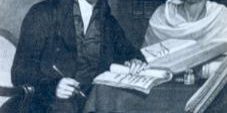
William Carey’s View of History
By Nathan Finn
One of the complaints I sometimes hear from students is that their church history and Baptist history classes are not “practical” enough. Instead of asking, with Tertullian, “what does Athens have to do with Jerusalem?” many of them want to know what any of it has to do with ministry in our contemporary context. Many of these same students complain similarly about their theology, ethics, biblical languages, and philosophy classes. My response is always to try and convince my more pragmatically minded students that history actually has a unique role to play in their theological education and can lend practical help to any number of contemporary concerns.
As Timothy George likes to say, there is a whole lot that happened in church history between Jesus and your grandma. Because we have two thousand years of Christian history behind us (as well as 400 years of uniquely Baptist history), we do not have to repeat the same mistakes that have already been made. We do not have to commit the same theological errors. We do not have to get trapped in some of the same practical quandaries. Our twenty-first century ministries can be informed by our forefathers from previous centuries. We can learn from their mistakes, and we can benefit from their successes. Your ministry should not occur in a historical vacuum.
William Carey understood this well. The second section of Carey’s famous An Enquiry into the Obligation of Christians to Use Means for the Conversion of the Heathens was devoted to historical precursors in foreign missions. Carey discussed New Testament missions, medieval Catholic missions, Reformation missions, New England missions, and especially Moravian missions. Though he is often known as the “father of the modern missions movement,” Carey was keenly aware that he stood in continuity with a long tradition of Christian cross-cultural evangelism. And he applied his knowledge of history to both his personal piety and his ministry.
History influenced the missiology of Carey and his associates. Scholars argue that the Moravians, David Brainerd, and John Eliot were all taken into consideration when Carey, Joshua Marshman, and William Ward drew up their famous Serampore Form of Agreement. In other words, Carey and friends understood that there was nothing new under the sun and they wanted to learn from the successes and failures of missionaries who had gone before them. History was used in the service of cross-cultural evangelism and church-planting.
In at least one case, history also served as an aid to Carey in his personal piety. Carey tells us in his journal and correspondence that he read regularly from David Brainerd’s famed diary. Like thousands of missionaries who have come after him, Carey found Brainerd a source of spiritual strength and missional inspiration. History was used in the service of personal piety.
My own desire is that we would use history in the same ways as Carey. As with Carey, ministry examples from the past have much to offer twenty-first century Baptists and other evangelicals. We have much to learn from the preaching of John Chrysostom, Ulrich Zwingli, and B. H. Carroll. We have much to learn from the evangelistic zeal of Francis of Assisi, Pilgram Marpeck, and Daniel Taylor. We have much to learn from the pastoral theology of Martin Luther, Richard Baxter, and Andrew Fuller. And we have much to learn from the missionary exploits of St. Patrick, Adoniram Judson, and Samuel Zwemer.
Past saints also have much to contribute to our present pursuit of godliness. We need the devotional theology of Athansius, John Owen, and John Dagg. We need the fire of Savonarola, John Wesley, and Charles Spurgeon. We need the gospel-saturated piety of John Bunyan, David Brainerd, and Robert Murray M’Cheyne. We need the same God-centered commitment to Christian scholarship as Jonathan Edwards, John Gill, and J. Gresham Machen.
William Carey resolutely believed that the sovereign Lord of all creation was moving history toward a glorious denouement when He will make all things new. Those who preceded Carey in the faith were a part of that history, even as he himself was a participant in all that God was doing to make His name great among the nations. You and I are also a part of that history, and it is my prayer that each of us will own Carey’s God-centered view of history as we seek to live rightly before God in our own time.
Nathan Finn (Ph.D., Southeastern Baptist Theological Seminary) is Associate Professor of Historical Theology and Baptist Studies at Southeastern Baptist Theological Seminary and an ordained Southern Baptist minister. Nathan is married to Leah and they are the parents of three children. The Finns are members of the First Baptist Church of Durham, where Nathan teaches theology classes and serves as a deacon. Nathan loves teaching at Southeastern because he enjoys showing students how church history applies to gospel ministry in the 21st century and why our historic Baptist identity is a heritage worth preserving. Nathan has contributed chapters to Calvinism: A Southern Baptist Dialogue (B&H) andSouthern Baptist Identity: An Evangelical Denomination Faces the Future (Crossway). He also blogs at OneBaptistPerspective.

